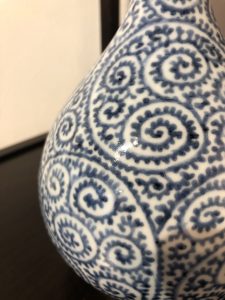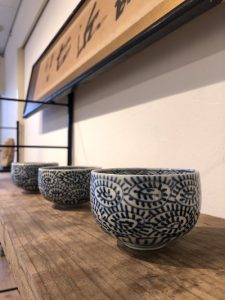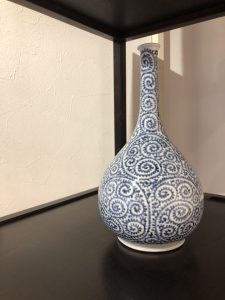染付蛸唐草文様について(愛知県名古屋市千種区姫池通 骨董買取致します 古美術風光舎名名古屋店)
2022.08.27
みなさまこんにちは、スタッフYでございます。
お仕事柄古いものを見る機会が多いものですから、日々常に思うことなのですが、時代をさかのぼればのぼるほど、そのものの事態の存在や、その形、色、デザインまでもそれぞれに意味を込め、その意味までも大切に受け継ぎながらここまで受け継がれているなということをひしひしと感じながらお仕事をしております。
先日弊店も染付の蛸唐草文様の茶碗をみてふと思ったのですが、この蛸唐草文様もその意味を持ち大切に受け継がれたものの一つでしょうか。かつては、物や情報があふれた時代ではありませんし、それらを伝えるツールももちろんありませんのでその意味や情報を文様で表すのは、自然のながれだったんだろう…などとぼんやり思っておりました。それにしてもこの蛸唐草文様からくる安心感、はたまたお茶目感は、なんなんでしょうね笑。
蛸唐草文様は文様の中でも皆さまおなじみ中のおなじみ唐草の一種なのでありますが、唐草文様と申しますと、昭和のどろぼうが運び出している風呂敷包みなんてイメージが…。(明治から昭和にかけて大人気だった唐草文様の風呂敷だったのですが)これには唐草文様もきっと、「いかがなものか」と、モノ申しそうではありますが、そのくらい人々に浸透されたのだとご容赦いただくこととして、長い歴史に意味を携えて現代まで現役生として生き残っている強者には間違いありません。

そもそも唐草文様のルーツは古くそして遠く、エジプト・メソポタミアに起源を持ち、中国から仏教と共に伝わったと考えられる「忍冬唐草文様」が祖形。あの法隆寺の玉虫厨子などにもみられる文様であります。そんな蔓をモチーフにしたデザインからみえるメッセージは、どこまでも生命力が強く途切れることなく蔓をのばしていくことから「繁栄・長寿」を意味します。
また、蔓(つる)は音読みではマンなので「万」と読み替えて、それが帯のようにつらなっていることから帯を音読みでタイ、タイを「代」と読み替えますと「万代」と読めますので、要するに一族の万代の繁栄、長寿の意味を持っているようですので、その起源や意味は古くそして由緒正しいようですね。
そんな唐草文様の種類の中のひとつである蛸唐草文様は、その文様が蛸の足に似ていることからついたものなであります。弊店にも何点か染付の蛸唐草模様の器などがございますが、手にしますとその丸い蔓の連続模様になぜだか安心感とお茶目な印象を感じることは否めません。また、当時の器は手描きゆえ、一つ一つ文様の染付の色や柄が少しずつちがっておりまして、チャームポイントを携えておりまして、これをお茶目といわずしてなんと言おうか。
こちらは幕末伊万里の染付蛸唐草の茶碗。

蛸唐草文様、古伊万里に描かれた文様の中では最もよく描かれた文様のひとつではあったようで、初期のものですと17世紀中頃に見られ、17世紀後半になりますと、蔓の先端が蛸の足の吸盤のように丸みを帯び、18世紀には描き方が簡略化。そして18世紀後半になりますと蔓の描き方が細い線のようで輪郭を引き、その中を丁寧に塗り埋めるのではなく太めの一本線で描くようになり、方渦の巻き方がゼンマイのよう多重になっていき、19世紀の色絵においては、葉の先端が少し曲がり膨らんだ、赤地のに金色で彩られた羊歯の葉のような唐草文が流行してくるようです。日本に入ってきてからもその様式は少しずつ変化を経ながら、こうして現在に生き残っているようです。
それにしてもここまで生き残ったのは、この安心感みたいなお茶目が人々の中に長年親しまれ(みんな好きだったんでじゃないかな。)受け継がれたからに違いないと私は勝手に思っているのですが。(話はもどる)そんなことよりも、私より間違いなく生き延びていく蛸唐草文様の進化や変化、私の目の黒いうちは見届けていきたいものです。
それでは、ごきげんよう。

Hello everyone, this is Staff Y.
As I have many opportunities to look at old things in the course of my work, I am constantly reminded that the further back in time we go, the more we realize that each item has its own meaning, including its existence, shape, color, and design, and that even its meaning has been carefully inherited and passed down to the next generation. I work with the sense that each item is passed down to the next generation with great care.
The other day, when I saw a tea bowl with an octopus arabesque design, I wondered if this octopus arabesque design is one of those that have been handed down with great care and meaning. In the past, we did not have an abundance of things and information, and of course we did not have the tools to communicate them, so it was a natural process to express the meaning and information with patterns…I thought absent-mindedly. Still, I wonder what the sense of security or mischievousness that comes from this octopus arabesque pattern is, lol.
The octopus arabesque pattern is one of the most familiar arabesques among the patterns, but the arabesque pattern gives me an image of a furoshiki wrapping cloth being carried out by a thief in the Showa period…. (The arabesque pattern was very popular from the Meiji period to the Showa period.) I am sure that the arabesque pattern would say, “What do you think of this? There is no doubt that they are strong.
The roots of the arabesque pattern are long and distant, originating in Egypt and Mesopotamia, and the ancestral form of the “ninja winter arabesque pattern” is thought to have been introduced from China along with Buddhism. This pattern can also be seen in the Tamamushi kitchen of Horyuji Temple. The message from the vine motif in the design is “prosperity and longevity,” as the vine has a strong and uninterrupted life force and will continue to grow.
The vine is read as “man,” which is pronounced “mann,” and since the vine is strung like a belt, the belt is read as “tai,” which is read phonetically as “tai” and “tai” as “dai,” which is read as “ten thousand generations,” so in short, it has the meaning of prosperity and longevity for the family for many generations, so its origin and meaning are old and venerable. It seems to be correct.
The octopus arabesque, one of the types of arabesque patterns, was named after its resemblance to the legs of an octopus. We also have some underglaze blue and white porcelain vessels with the octopus arabesque pattern, and when you hold them in your hands, you can’t deny that the continuous pattern of round tendrils gives you a sense of security and a mischievous impression. Moreover, because these vessels were hand-painted at that time, the colors and patterns of the underglaze blue patterns are slightly different one by one, and they have their own charm points.
This is an Imari Imari tea bowl from the end of the Edo period.
The octopus arabesque pattern seems to have been one of the most frequently drawn patterns in Ko-Imari, and it can be seen in the middle of the 17th century in the early ones, and in the latter half of the 17th century, the tip of the vine is like a sucker of an octopus’s foot. In the late 17th century, the tips of the vines became rounded like the suckers on the legs of an octopus, and in the 18th century, the drawing style was simplified. In the latter half of the 18th century, the vines were drawn with a single thick line, rather than being outlined with thin lines and carefully filled in with paint, and the whorls became multiple, like those of a spring. In the 9th century, arabesque designs with the tips of the leaves slightly bent and bulging, like leaves of a sheep’s tooth painted in gold on a red ground, became popular. This style has survived in Japan to the present day while undergoing gradual changes.
I think that the reason it has survived this long is because people have long been familiar with and passed on this sense of security and mischievousness. (Back to the story.) More than that, I would like to see the evolution and change of the octopus arabesque pattern, which will undoubtedly continue to survive, while my eyes are still black.
So long, and have a good day.
*********************
ご実家の整理やお片付けなどをされている方のご相談などが多くございます。お暑い日が続きますのでくれぐれもご無理のないように、なさってくださいませ。風光舎では、古美術品や骨董品の他にも絵画や宝石、趣味のお品など様々なジャンルのものを買受しております。
お片付けをされていて、こういうものでもいいのかしらと迷われているものでも、どうぞお気軽にご相談下さいませ。
また風光舎は、出張買取も強化しております。ご近所はもちろん、愛知県内、岐阜県、三重県その他の県へも出張いたします。
まずは、お電話お待ちしております。
愛知県名古屋市千種区・骨董 買取
『古美術 風光舎 名古屋店』
TEL052(734)8444
10:00-17:00 OPEN

